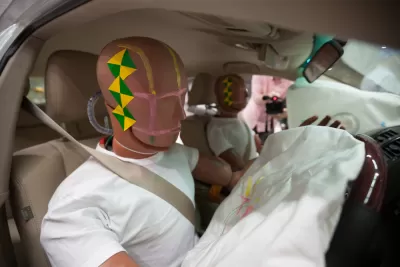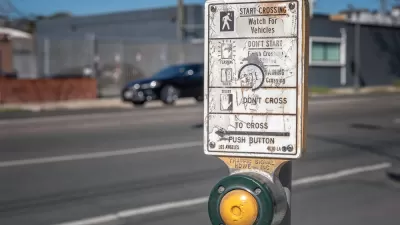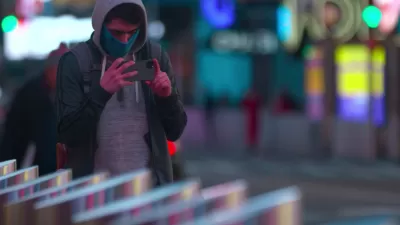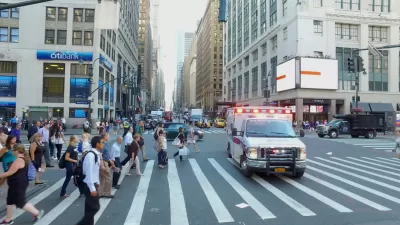What can we learn from our Covid response?

I come from the field of traffic safety. That was, unto this point, too boring of a topic for the average American—or reporter—to give much serious consideration.
We still find traffic deaths almost unbearably unsexy as a topic. It has become common during the pandemic, however, to trot them out to make rhetorical points, especially in favor of the kind of highly partisan battles that have characterized much of our response.
A conservative commenter might point out that we face risk every day while driving, and that risk is a part of life. We accept those risks.
A liberal commenter might point to the mandated use of seatbelts as a defense of masks.
Even prior to Covid we fell into this pattern: We have always used traffic deaths as a way to gauge what is a socially acceptable number of deaths. These kinds of deaths are always out of focus, used as a benchmark against which to gauge other tragic and fatal phenomena. Before Covid, we compared gun deaths, suicides, and opioid deaths to traffic deaths in the same casual way, with our attention always distracted from the point of the comparison. Traffic deaths were the high-water mark to measure against what we considered an acceptable number of deaths.
That has changed a little bit recently as traffic deaths have surged during the pandemic, inspiring an unusual, if modest, round of media attention. A new report from the National Safety Council estimates traffic deaths grew 9 percent in 2021. Compared to 2019, traffic deaths are up 19 percent.
A two-year, almost 20 percent rise in deaths might not sound that alarming, especially given what’s happened in the last two years with Covid. But for the few of us that are interested in traffic safety, it is very concerning. Since the 1970s, when we began regulating cars for safety—adding things like seat belts and airbags, for example—the general pattern we could expect in traffic fatalities was sustained decline. Sometimes it would vary a little; people drive less during recessions and that tends to lower traffic deaths, for example.
But what we’ve seen during the pandemic has been very different. Instead, we saw driving miles totally detach from traffic deaths. In 2020, when we were deep in the “stay home” phase of the pandemic, driving miles decreased substantially, but traffic deaths—especially to vulnerable people like pedestrians—roared to new heights.
A recent article and follow up in the New York Times attributed the increase to an increase in reckless and anti-social driving behavior—basically more social fallout from the pandemic.
But even prior to the pandemic, the United States was falling behind its peer nations on traffic safety. Some of the international leaders in Europe—Scandinavian nations mostly—have annual per-capita traffic death rates as little as one quarter or one fifth as ours. A group of peer nations like Spain improved traffic safety over the previous decade at on average twice the rate of the United States, according to an analysis by the CDC released prior to the pandemic. Even Canada sees about half as many deaths on a per-capita basis as the United States now.
I hesitate to compare these deaths to the pandemic, as these comparisons are obviously all so fraught. But it’s hard for me, just like it is for reporters covering any mass death phenomenon, to resist.
We have to remain humble enough to really listen. The goal really isn’t to end death, which is impossible, but to maximize our well being.
Even as traffic deaths rise at alarming rates, they are still well below Covid numbers—and it’s really not even close.
The National Safety Council estimates 46,000 people died in traffic in 2021. That estimate is higher than the National Highway Transportation Safety Administration’s: 38,000 for 2020. (That organization calculates traffic deaths a little differently, for example, excluding traffic deaths that occur on private property, in driveways, or parking lots.)
But compared to Covid deaths, the people that die in traffic crashes tend to be young. Even at the height of the pandemic, before vaccines, people 35 and younger were more likely to die in a car crash in the United States than of Covid. Drivers in their teens and 20s, especially boys and rural dwellers, die at staggering rates in the United States. Most years—although suicides and opioids are now often neck and neck—it is the number one reason parents in the United States bury their children.
Though we treat it almost like a natural phenomenon, we do have fair amount of control—with policies and road design conventions—over the number who die on our roads. Groups like the National Safety Council, for example, estimate we could save 10,000 lives a year just by employing currently available technologies on cars—like automatic emergency breaking, pedestrian detection, and passive drunk driving detection. Nevertheless, we have, until recently, shied away from mandating that kind of life saving technology.
The European Union—which takes these deaths more seriously—is moving ahead this year with automatic speed governors, which will prevent cars from speeding. In the United States, where we have around 10,000 speeding deaths a year, federal regulators have shied away from bold action on speeding. We have resisted adding speed limiting technology even to heavy commercial trucks, thanks to lobbying by the trucking industry.
In an effort to shift this culture of complacency, many people from the field of traffic safety and urban planning—my domain—have tried to advance the notion of “Vision Zero.” Vision Zero is a Swedish invention. The premise is basically that we shouldn’t tolerate any number of traffic deaths as acceptable, or the cost of doing business, and we should seek design roads and cars to be “forgiving” when the inevitable driving mistakes occur.
In the United States, this idea is often dismissed wholesale or thought of as unserious or unrealistic—to the point where the underlying importance of the point its proponents try to make is almost lost in the goal of whether zero deaths is really possible.
Even some of the Scandinavian nations the pioneered the idea have had setbacks in recent years trying to implement such an ambitious goal. But there are also glimmers of promise. The city of Oslo, Norway, (population: 637,000) had just one traffic death in 2019. (It should be noted that was after the city essentially banned cars from a square-mile area in the central city.)
We saw a very similar term—"Covid Zero”—arise during the pandemic. But it has mostly been abandoned by now. The idea being that no Covid deaths or cases should be tolerated. This notion led to what are arguably some pretty oppressive public health responses like forced lockdowns in China and closed borders in Australia.
The number of Covid deaths tossed around now for is 1 million—a staggering number. One million U.S. Covid deaths. A condemnation in itself.
Still, sometimes I find myself wondering if the price paid—the educations of so many American children, especially low income, derailed, the severed social ties, the increases in aggressive behavior, the lost mom and pop businesses—was worth it. And I don’t think it’s such an easy moral question to answer and the popular conversation implies: Often in my (liberal) circles in glib, moralizing soundbites (“of course,” they say, “anything to save a life”).
I think often it’s expedient—in the same sort of political point-scoring way I mentioned earlier—to imply they were all preventable. But as the pandemic wore on, deaths surging and then falling following the mysterious two-month wave pattern, I have come to doubt that.
Any comparison will be imperfect. The coronavirus is a rapidly mutating contagious virus. Traffic deaths are a man-made problem that has only existed for a little over 100 years. We are interconnected in some of the same ways and so are our fates. And I don’t mean to imply they aren’t alike: we are dependent on an interconnected system that is very reliant on driving.
With both covid and traffic deaths, most of us are more or less passive participants. Few have any direct power to affect the outcome. It requires cooperation and coordinated action, a kind of moral consensus we have struggled with during the pandemic.
It’s important to acknowledge that “saving lives” nearly always requires tradeoffs. Do we accept the cost of slightly more expensive cars—or alternatively consumer goods carried on trucks—so that some mother doesn’t have to bury her daughter? Often, we don’t even ask this question. In traffic safety, it is rejected by default, never even considered.
In the opposite vein, I think we can also cause harm by being too dogmatic about “saving lives” as well. How many inner-city school children is it worth keeping out of school for a year—inflicting potentially lifelong harms—to save how many lives? And who’s lives are being saved? Are we merely extending the lives of more well off older (whiter) people with policies that have harmed lower-income groups with lower political power (children, essential workers)?
Those are the kinds of questions I find myself grappling with now. I don’t think there are a lot of easy answers. What is considered an acceptable death has always been political and mediated by many things, maybe most importantly the social status of the victim. As strange as it’s always seemed to me, the perceived novelty—or injustice—of the way they die seems to have an influence as well. We aren’t completely unbiased and judicious about this. And it would be impossible to be so. Morally, we instinctively recognize all deaths are not equally tragic, but it’s been tough to discuss honestly during the pandemic, given how polarized and generally awful the discussion has been.
It’s also important to acknowledge that at some point death is going to come for all of us. And we can’t discount that living well and fully is something we have a clear social interest in promoting as well.
I don’t know what the failure of “Covid Zero” means for “Vision Zero” and I wonder about it myself. I don’t think the mistakes made in the U.S. pandemic response will be helpful to the cause of redoubling efforts toward traffic safety. A lot of people have been harmed by our pandemic policies and those harms are not distributed evenly. We’re still sorting through the fallout right now, including apparently, with rising traffic deaths.
As we look back at the pandemic, will we find those costs justified? Do we think they were effective? I wish I felt more confident about that myself. I know I’m not as confident as I once was.
There’s been some promising developments in traffic safety recently—the first major ones for a long time. A little known provision hidden in the Infrastructure Investment and Jobs Act would require some new technology in cars—automatic emergency braking, passive drunk driving detection—that have the potential to save a lot of lives. These are technologies that are standard already in a lot of new luxury vehicles.
In addition, Pete Buttigieg, the secretary of the U.S. Department of Transportation, recently unveiled a goal of zero traffic deaths by 2050. (Full disclosure: I worked on the campaign to encourage them to make the commitment.)
2050 is a long way from now. By then we could have automated cars—who knows. A lot is possible in a generation. And maybe zero traffic deaths will never be achieved in the United States. (I sometimes wonder if the goal compatible with having an interstate highway system for example.)
Nevertheless, the administration’s stated commitment to “zero,” is an important policy change, and framing of how we view traffic deaths. For years, the National Highway Traffic Safety Agency pursued only the most modest, incremental improvements in traffic safety. The agency’s policy was to aim for a 4 or 5 percent reduction in traffic deaths from the year before. The annual official “goal” of the agency charged with improving traffic safety might be 35,000 or more deaths on roadways a year.
Obviously, it will take a long time and a lot of effort, but it’s becoming more and more clear that we can do better. There are levers we could pull as a society that would prevent some people from losing family members or sustaining life altering injuries in this common, very American way.
And if we look back further in our history there are great public health success stories: Smoking cessation. Our progress against AIDS. But we also see new epidemics can arise, even man made like the opioid epidemic, arising out of the benefits of advanced medicine.
Maybe it’s grandiose to imagine that traffic deaths could ever capture the public imagination the way covid did over the last few years. And maybe that’s appropriate anyway. We have an attention economy, I believe, and many worthy issues compete for our attention. And covid was a much, much larger killer during 2020 and 2021 than traffic crashes.
I do think traffic deaths and injuries are worthy of more attention than they have gotten, and that lack of attention leads to a good number of preventable deaths.
I guess what I'm trying to say is I hope we can find a healthier balance. If we someday succeed in creating the space for serious challenges to the culture of complacency around traffic deaths, we can avoid falling into some of the same traps we did with covid. I hope we can avoid being too dogmatic and listen to people who are negatively impacted by the policies with open hearts and minds and always strive for policies that consider people’s well being in a wholistic sense. These are very delicate moral matters and no one person or group has a monopoly on insight. We have to remain humble enough to really listen. The goal really isn’t to end death, which is impossible, but to maximize our well being.
Angie Schmitt is a writer and planner based in Cleveland. She is the author of Right of Way: Race, Class and the Silent Epidemic of Pedestrian Deaths in America (Island Press, 2020). She is founding principal at 3MPH Planning, a small Cleveland based firm focused on pedestrian safety.

Study: Maui’s Plan to Convert Vacation Rentals to Long-Term Housing Could Cause Nearly $1 Billion Economic Loss
The plan would reduce visitor accommodation by 25,% resulting in 1,900 jobs lost.

North Texas Transit Leaders Tout Benefits of TOD for Growing Region
At a summit focused on transit-oriented development, policymakers discussed how North Texas’ expanded light rail system can serve as a tool for economic growth.

Using Old Oil and Gas Wells for Green Energy Storage
Penn State researchers have found that repurposing abandoned oil and gas wells for geothermal-assisted compressed-air energy storage can boost efficiency, reduce environmental risks, and support clean energy and job transitions.

Santa Barbara Could Build Housing on County Land
County supervisors moved forward a proposal to build workforce housing on two county-owned parcels.

San Mateo Formally Opposes Freeway Project
The city council will send a letter to Caltrans urging the agency to reconsider a plan to expand the 101 through the city of San Mateo.

A Bronx Community Fights to Have its Voice Heard
After organizing and giving input for decades, the community around the Kingsbridge Armory might actually see it redeveloped — and they want to continue to have a say in how it goes.
Urban Design for Planners 1: Software Tools
This six-course series explores essential urban design concepts using open source software and equips planners with the tools they need to participate fully in the urban design process.
Planning for Universal Design
Learn the tools for implementing Universal Design in planning regulations.
Ascent Environmental
Borough of Carlisle
Institute for Housing and Urban Development Studies (IHS)
City of Grandview
Harvard GSD Executive Education
Toledo-Lucas County Plan Commissions
Salt Lake City
NYU Wagner Graduate School of Public Service





























